Carpobrotus edulis
Carpobrotus edulis (L.) L.Bolus
Family: Aizoaceae
Common names: sour fig, Cape fig, Hottentots fig (Eng.); ghaukum, ghoenavy, Hottentotsvy, Kaapsevy, perdevy, rankvy, suurvy, vyerank, (Afr.); ikhambi-lamabulawo, umgongozi (Zulu)
Introduction
Carpobrotus edulis is an easy-to-grow succulent groundcover, ideal for low-maintenance and water-wise gardens. It is also a useful first-aid plant with edible fruits for the herb or kitchen garden.

Description
Description
A robust, flat-growing, trailing perennial, rooting at nodes and forming dense mats. The succulent horizontal stems curve upwards at the growing point. The leaves are succulent, crowded along the stem, 60-130 x 10-12 mm, sharply 3-angled and triangular in cross-section, yellowish to grass-green, and reddish when older.
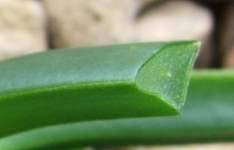
Flowers are solitary, 100-150 mm in diameter, yellow, fading to pale pink, produced mainly during late winter-spring (August-October). They open in the morning in bright sunlight, and close at night. Look into the centre of the flower and you'll see many stamens surrounding a beautiful starfish-like stigma. This species is easily
distinguished from the others as it is the only one with yellow flowers.
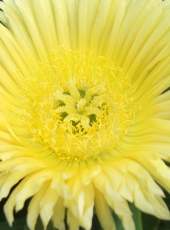
Fruit is fleshy, indehiscent and edible, 35 mm in diameter, shaped like a spinning top, on a winged stalk, becoming yellow and fragrant when ripe. The outer wall of the fruit becomes yellowish, wrinkled and leathery with age. The seeds are embedded in the sticky, sweet, jelly-like mucilage. The fruits can be eaten fresh and they have a strong, astringent, salty, sour taste. They are not as tasty as those of C. acinaciformis and C. deliciosus which are sweeter.
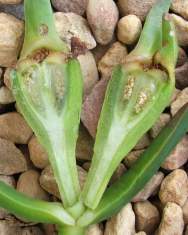
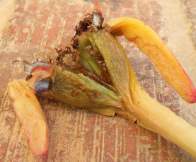
C. edulis is divided into the two subspecies: C. edulis subsp. edulis and C. edulis subsp. parviflorus which has smaller flowers, only reaching 50 mm in diameter, and occurs in the Du Toitskloof Mountains.

Conservation Status
Status
Carpobrotus edulis is not regarded as threatened in its native habitat, but it is invading natural areas in other parts of the world and threatening the survival of other species. In California, where it has been used since the early 1900s to stabilize the soil along railway tracks and roadsides and as a garden ornamental, it has naturalized and is invading coastal vegetation from north of Eureka to Rosarita Bay. It is known as the highway ice plant in the USA.
It has naturalized along the west coast of Australia from Perth to Albany where it was also used for soil stabilization and is known as pigface. It has naturalized in parts of the Mediterranean and on the south coast of England.
Distribution and habitat
Distribution description
Carpobrotus edulis grows on coastal and inland slopes from Namaqualand in the Northern Cape through the Western Cape to the Eastern Cape. It is often seen as a pioneer in disturbed sites.
Derivation of name and historical aspects
History
Carpobrotus is derived from the Greek, karpos, meaning fruit, and brotos, meaning edible. The Latin words, edulis, means edible, and parviflorus means with small flowers. The Afrikaans common names ghaukum and ghoenavy come from old Khoi names for the plant. The name Hotnotsvy (Hottentots fig) was in use as long ago as 1685 and is probably derived from the fact that the colonists observed the Khoikhoi using this plant and eating its fruits. It got the name vy (meaning fig and pronounced fay) because the developing fruits superficially resemble figs but it is in no way related to figs ( Ficus species, family Moraceae, the mulberry and fig family).
Carpobrotus consists of 13 species, seven of which occur in southern Africa. See below for details of the other r six southern African species.
Ecology
Ecology
Leaves are eaten by tortoises. Puff-adders and other snakes such as the Cape Cobra are often found in Carpobrotus clumps where they ambush the small rodents that are attracted by the fruits. Flowers are pollinated by solitary bees, honey bees, carpenter bees and many beetle species. Flowers are eaten by antelopes and baboons. The clumps provide shelter for snails, lizards and skinks. Fruits are eaten by baboons, rodents, porcupines, antelopes and people, who also disperse the seeds.
Uses
Use
The leaf juice is astringent and mildly antiseptic. It is mixed with water and swallowed to treat diarrhoea, dysentery and stomach cramps, and is used as a gargle to relieve laryngitis, sore throat and mouth infections. Chewing a leaf tip and swallowing the juice is enough to ease a sore throat. Leaf juice or a crushed leaf is a famous soothing cure for blue-bottle stings-being a coastal plant it is luckily often on hand in times of such emergencies. The leaf juice is used as a soothing lotion for burns, bruises, scrapes, cuts, grazes and sunburn, ringworm, eczema, dermatitis, sunburn, herpes, nappy rash, thrush, cold sores, cracked lips, chafing, skin conditions and allergies. An old and apparently very powerful remedy for constipation is to eat fruits and then drink brackish water. Syrup made from the fruit is said to have laxative properties. A mixture of leaf juice, honey and olive oil in water is an old remedy for TB. The leaf juice also relieves the itch from mosquito, tick and spider bites both for people and their animal companions. The Khoikhoi took an infusion of the fruits during pregnancy to ensure a strong, healthy baby and an easy birth and smeared leaf sap over the head of a new-born child to make it nimble and strong. In the Eastern Cape it is also used to treat diabetes, and diptheria.
Fruits are eaten by people and have been since ancient times. Archaeologists have found plants covering ancient middens along the coast and sometimes marking Khoikhoi burial sites (UCT Summer School lecture).
The sour fig is frequently cultivated as a sand binder, groundcover, dune and embankment stabilizer, and fire-resistant barrier and also a superb water-wise plant.
Growing Carpobrotus edulis
Grow
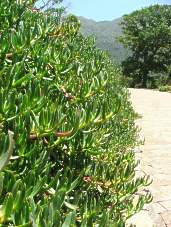
Carpobrotus edulis is easy to grow, one of those plants that thrive on neglect and can be killed with kindness. It needs well-drained soil, a sunny position and room to spread. It is an excellent evergreen drought-, and wind-resistant groundcover that can be planted on flat, sandy ground, on loose sand dunes, gravelly gardens, lime-rich and brackish soils as well as in containers, rockeries, embankments and will cascade over terrace walls. It is relatively shallow-rooting and is a good choice for a roof garden. Very effective when planted as a groundcover around the house to create a fire-resistant barrier in fire-prone areas. Carpobrotus edulis is not frost-hardy.
Carpobrotus edulis roots easily from cuttings. Take 200-300 mm long tip cuttings during the summer. No rooting hormone or mist unit is required, either plant them where they are intended to grow or directly into a container filled with well-drained potting soil. Seed can be sown in spring, early summer or autumn. Seedlings damp off easily and must be grown in pure sand for best results.
High humidity will cause bacterial rot of the leaves. Plants in shady positions or poorly drained sites are often affected by fungal diseases ( Botrytis ). Snails cause leaf damage in damp gardens. Plants in old clumps may die back in the centre. Over-fertilizing will cause wilt and die-back.
Species

C. acinaciformis (sour fig, elandsvy, goenavy, Hotnotsvy, strandvy, suurvy ) has purple flowers, robust, short, greyish green, sabre-shaped leaves and tasty edible fruits, used to make a delicious jam, and grows in coastal sands usually close to the sea, in the Western Cape, from Saldanha to Mossel Bay.

C. deliciosus (sour fig, perdevy, ghaukum, ghounavy ) has purple, pink or white flowers, almost straight, reddish green leaves and sweet fruits that make excellent sour fig preserve. It grows on sand dunes and in rocky grassland along the southern and eastern coast of South Africa from Riversdale in the Western Cape through the Eastern Cape to KwaZulu-Natal.

C. dimidiatus ( Natal dune vygie, Natalse-kusvy, strandvygie, ikhambi-lamabulawo, umgongozi ) has rose-purple flowers and grows on dunes in the Eastern Cape to KwaZulu-Natal and Mozambique.

C. mellei (mountain sour fig, berg-rankvy, berg-suurvy ) is the only species that occurs in the fynbos on sandstone mountain slopes inland, it is found only in the Western Cape in the Hottentots Holland Mountains, the Langeberg and the Swartberg. It has pink or purple flowers, narrow small leaves and a small club-shaped fruit.

C. muirii (dwarf sour fig, dwergsuurvy ) is similar to C. deliciosus but has narrower leaves and is only found only in the Strandveld in the Western Cape, from De Hoop to Stillbaai.
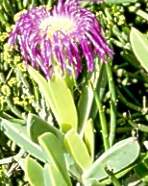
C. quadrifidus (including C. sauerae), (West Coast sour fig, Weskus suurvy, elandsvy) has large violet-pink, pale pink or white flowers-the largest flower found in the family Mesembryanthemaceae-and straight, stubby grey leaves and grows in sandy lowlands along the west coast from southern Namaqualand in the Northern Cape to Saldanha in the Western Cape.
References
- Van Jaarsveld, E.J. and De Villiers Pienaar, U. 2000. Vygies, gems of the veld. A garden and field guide to the South African mesembs. Cactus & Co., Grafica Quadro, Tradate, Italy.
- Germishuizen, G. & Meyer, N.L. (eds). 2003. Plants of southern Africa : an annotated checklist. Strelitzia 14. National Botanical Institute, Pretoria.
- Leistner, O.A. (ed.) 2000. Seed plants of southern Africa : families and genera. Strelitzia 10. National Botanical Institute, Pretoria.
- Goldblatt, P. & Manning, J. 2000. Cape plants. A conspectus of the Cape flora of South Africa. Strelitzia 9. National Botanical Institute, Pretoria & Missouri Botanical Garden Press, Missouri.
- California Invasive Plant Council http://ucce.ucdavis.edu
- Hutchings, A. 1996. Zulu medicinal plants: an inventory. University of Natal Press, Pietermaritzburg.
- Roberts, M. 1990. Indigenous healing plants. Southern Book Publishers, Halfway House, South Afirca.
- Smith, C.A. 1966. Common names of South African plants. Memoirs of the Botanical Survey of South Africa No. 35.
Credits
Christien Malan & Alice Notten
Kirstenbosch National Botanical Garden
January 2006
Plant Attributes:
Plant Type: Ground Cover
SA Distribution:
Soil type: Sandy, Brack/saline
Flowering season: Spring
PH: Acid, Alkaline, Neutral
Flower colour: Yellow
Aspect: Full Sun
Gardening skill: Easy
Special Features:
Horticultural zones








Rate this article
Article well written and informative
Rate this plant
Is this an interesting plant?
Login to add your Comment
Back to topNot registered yet? Click here to register.